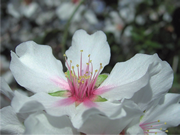 |
Billowing pink and white clouds of almond blossom are one of the first harbingers of the New Year in Southern Spain. The frivolous froths of petals seem too delicate to withstand the often icy winds that we can experience in the early parts of the year but, although strong winds can set the petals flying, the trees themselves are surprisingly hardy. From the blackened and rather gaunt looking winter branches, the flower buds swell up and burst open in the winter sunshine covering the hillsides with pink and white powder puffs. |
Billowing pink and white clouds of almond blossom are one of the first harbingers of the New Year in Southern Spain. The frivolous froths of petals seem too delicate to withstand the often icy winds that we can experience in the early parts of the year but, although strong winds can set the petals flying, the trees themselves are surprisingly hardy. From the blackened and rather gaunt looking winter branches, the flower buds swell up and burst open in the winter sunshine covering the hillsides with pink and white powder puffs.
Botanically known as prunus amygdalus, (referring to the ‘tonsil’ shape of the nut) it is closely related to the peach, nectarine, plum and cherry. As long ago as 4,000 B.C. the almond was used and almost every major ancient civilisation has recognised its value. Its exact origens are unknown; one theory has it originating in China and Central Asia, whilst some believe it came from the steppes of what was formerly the Soviet Union. Travellers on the Silk Route almost certainly brought it into Europe and it seems that the first European plantings were in Greece. The Romans called it the ‘Greek nut’. It was highly valued for its nutritional content and sugared almonds were presented as gifts to visiting dignitaries. In Greek mythology, the almond tree is represented by Phyllis, a beatutiful princess who died of a broken heart when her betrothed left her waiting at the altar. The Gods turned her into a tree, but leafless and bare. When her fiancee arrived he wept to see such a sad tree and his tears converted into the beautiful almond blossom we know today. Subsequently, at weddings, almonds were thrown at happy couples as a symbol of strength and fertility and, to this day, small nets of sugared almonds are given to wedding guests in many Mediterranean countries.Because it stored so well and was easy to transport, the nut spread apace with the mighty Roman Empire and waBillowing pink and white clouds of almond blossom are one of the first harbingers of the New Year in Southern Spain. The frivolous froths of petals seem too delicate to withstand the often icy winds that we can experience in the early parts of the year but, although strong winds can set the petals flying, the trees themselves are surprisingly hardy. From the blackened and rather gaunt looking winter branches, the flower buds swell up and burst open in the winter sunshine covering the hillsides with pink and white powder puffs.
Botanically known as prunus amygdalus, (referring to the ‘tonsil’ shape of the nut) it is closely related to the peach, nectarine, plum and cherry. As long ago as 4,000 B.C. the almond was used and almost every major ancient civilisation has recognised its value. Its exact origens are unknown; one theory has it originating in China and Central Asia, whilst some believe it came from the steppes of what was formerly the Soviet Union. Travellers on the Silk Route almost certainly brought it into Europe and it seems that the first European plantings were in Greece. The Romans called it the ‘Greek nut’. It was highly valued for its nutritional content and sugared almonds were presented as gifts to visiting dignitaries. In Greek mythology, the almond tree is represented by Phyllis, a beatutiful princess who died of a broken heart when her betrothed left her waiting at the altar. The Gods turned her into a tree, but leafless and bare. When her fiancee arrived he wept to see such a sad tree and his tears converted into the beautiful almond blossom we know today. Subsequently, at weddings, almonds were thrown at happy couples as a symbol of strength and fertility and, to this day, small nets of sugared almonds are given to wedding guests in many Mediterranean countries.
Because it stored so well and was easy to transport, the nut spread apace with the mighty Roman Empire and wa Europe. Spain and Italy were the major producers, the nuts being particularly valued because of their ability to withstand adverse weather conditions and, particularly, drought. The Spanish took the almond to the New World and, in the mid 1700’s, Franciscan monks planted the trees in California. Today, central California has some 530,000 acres planted to almonds and supplies almost 75% of world requirements. The almond crop ranks no.7 in U.S. food production. Just another example of superior marketing and intense horticultural practises overtaking the more piecemeal plantings of southern Europe.
The trees should be planted during the winter months, before the flower and leaf buds start to break – this gives the roots a chance to establish. They like relatively mild winters, long hot summers and a well-drained soil so Andalucía suits them well. Production will start at 3 to 4 years old, but they are at their most productive from around 8 years old and will continue cropping well for 50 years. Bees are the main pollinators – during February in California around one million hives are trucked into the almond groves, half of the beehive population, to ensure good fruit set.
Prunus amygdalus var. dulcis is the sweet almond and the one that we commonly eat and from which we extract a delicate oil, used in aromatherapy, cosmetics etc. Prunus amygdalus var. amara is the bitter almond which contains high levels of prussic acid. It is not safe to eat large amounts of this nut, though an intensely flavoured oil is extracted from it which is used in the distillation of the liqueur Amaretto and in marzipan production etc.
In Spain, the second largest almond producer in the world, around 100 varieties of almond are grown but, of these, only 5 are commercially recognised. These are Marcona, Largueta, Planeta, Valenciana and Mallorca.The first three are most grown, with Valenciana and Mallorca being planted in their respective areas.An average of 45,000 metric tons are harvested yearly and, of this, over half are used in the bakery and confectionary industries, a legacy from the days of Moorish occupation. The turron industry uses a large proportion of this, with some 36,000 tonnes produced annually, with a value of around €220 million. Marcona is the preferred variety for this and also for salting for snacks, whilst Largueta and Planeta, which are larger, are more generally used for sugar or chocolate coated sweets.
With a long and varied history, the almond has been a symbol of both virginity and fertility; used in folk medicine for cancers, tumours, ulcers and corns. Almond branches were used as divining rods in Italy and even King Tutankhamun took almonds with him to his grave in 1352B.C. to nourish him on his journey into the afterlife. A more modern input if you’re not yet ready for the afterlife – almonds are thought to prevent alcoholic intoxication. Should have told you that one on New Year’s Eve, shouldn’t I?
Lorraine Cavanagh is the author of Mediterranean Garden Plants.
Her plant nursery, Viveros Florena, is on the Algarrobo/Cómpeta Road, 15km up from the coast. Look out for the flowerpot lady. Also, catch her weekly shows on OCI radio.
NEW WINTER OPENING HOURS: Tuesday to Saturday, 10am – 4pm.






















